|
MAY 24, 2014
Finger length re-defined: evolution, genetics & hormones!
For more than a century finger length (proportion) has been known to represent a manifestation of genetics & hormones combined.
Unfortunately, the assessment of finger length proportion has not been defined very well. So far nearly all sources have defined finger length proporation relative to a single aspect of the palm: some sources use palm length, other sources use palm breadth (= hand width measured at the metacarpals).
But interestingly, the argument for using only palm length or palm breadth is missing: it appears that choices in the past were made on just arbitrary preferences.
Therefore this article proposes a new more detailed approach to re-define finger length proportion: finger length relative to the average of (both) palm length and palm width together, the so-called 'finger length index'!
The picture below (click HERE for large version) presents a detailed overview of how finger length proportion tends to vary with genetic- and hormonal characteristics. Both palm length and palm width represent likewise significant points of reference, and therefore the 'finger length index' presents the opportunity to combine both aspects of the palm in order to produce results that are most likely significant.
The sequence of this article describes how finger length correlates with evolution, genetics & hormones, including an impression of how finger length varies between human populations (e.g. men & women, nations & ethnic groups, plus the most common genetic disorders), and how finger length varies between primate families & species.
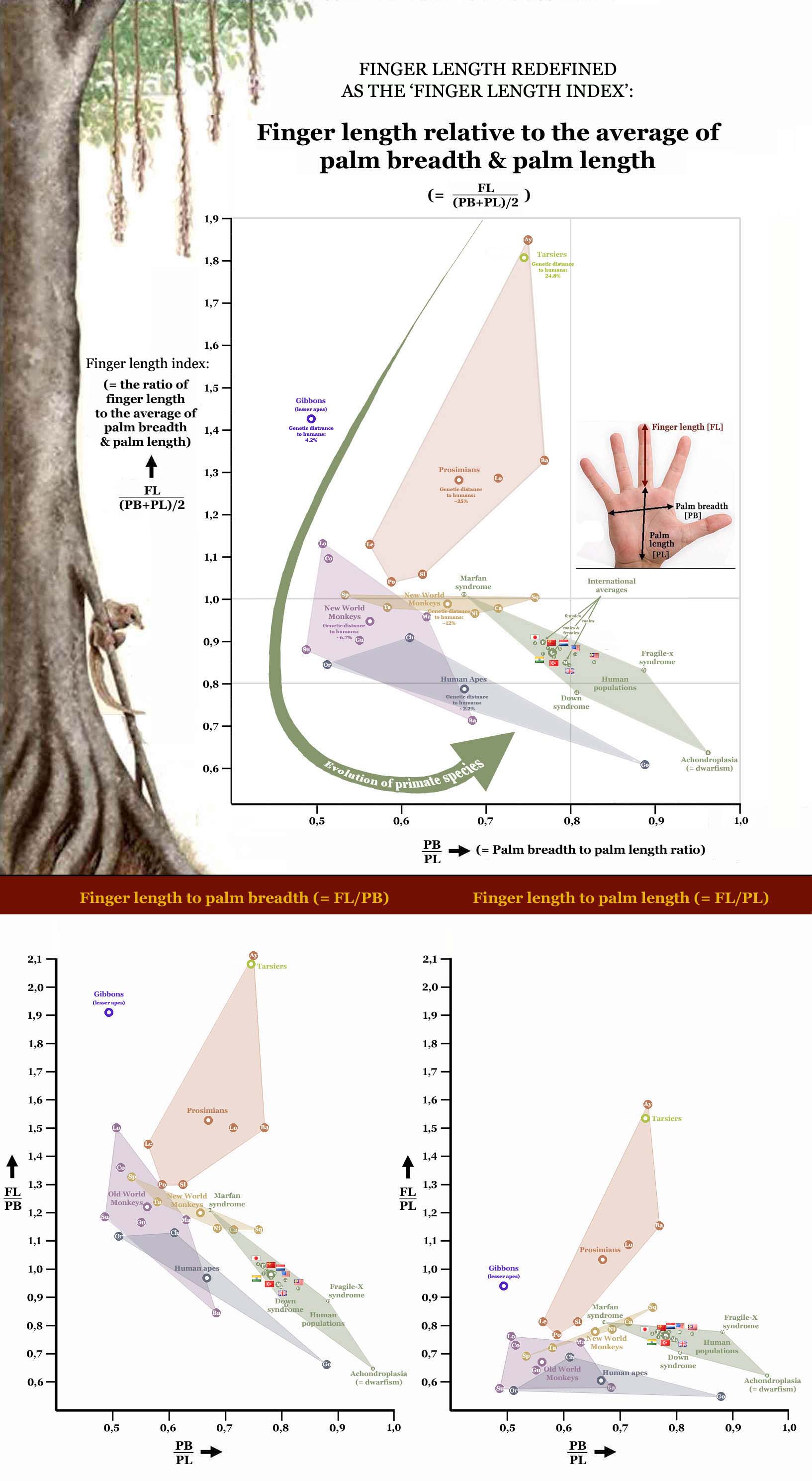
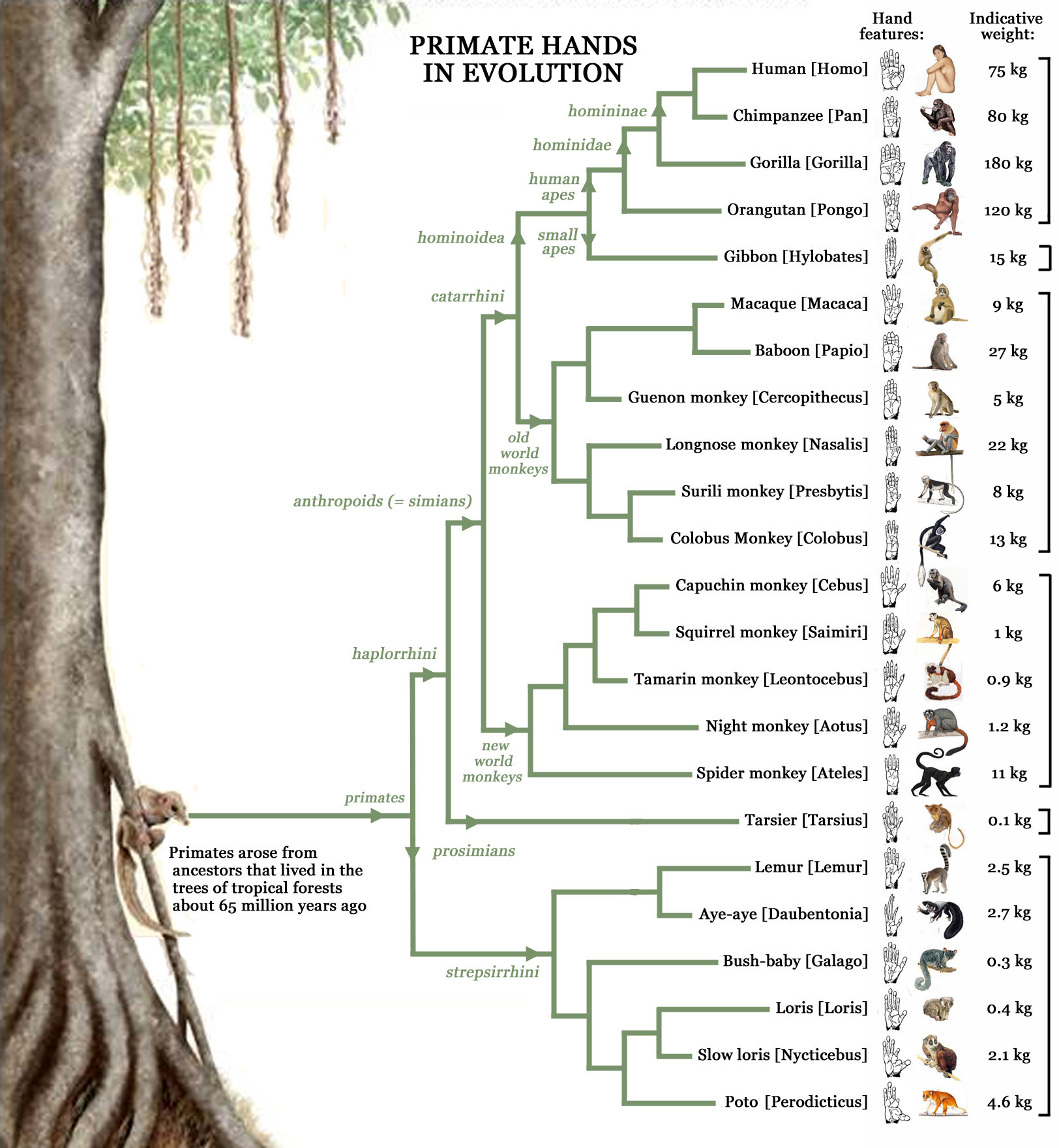
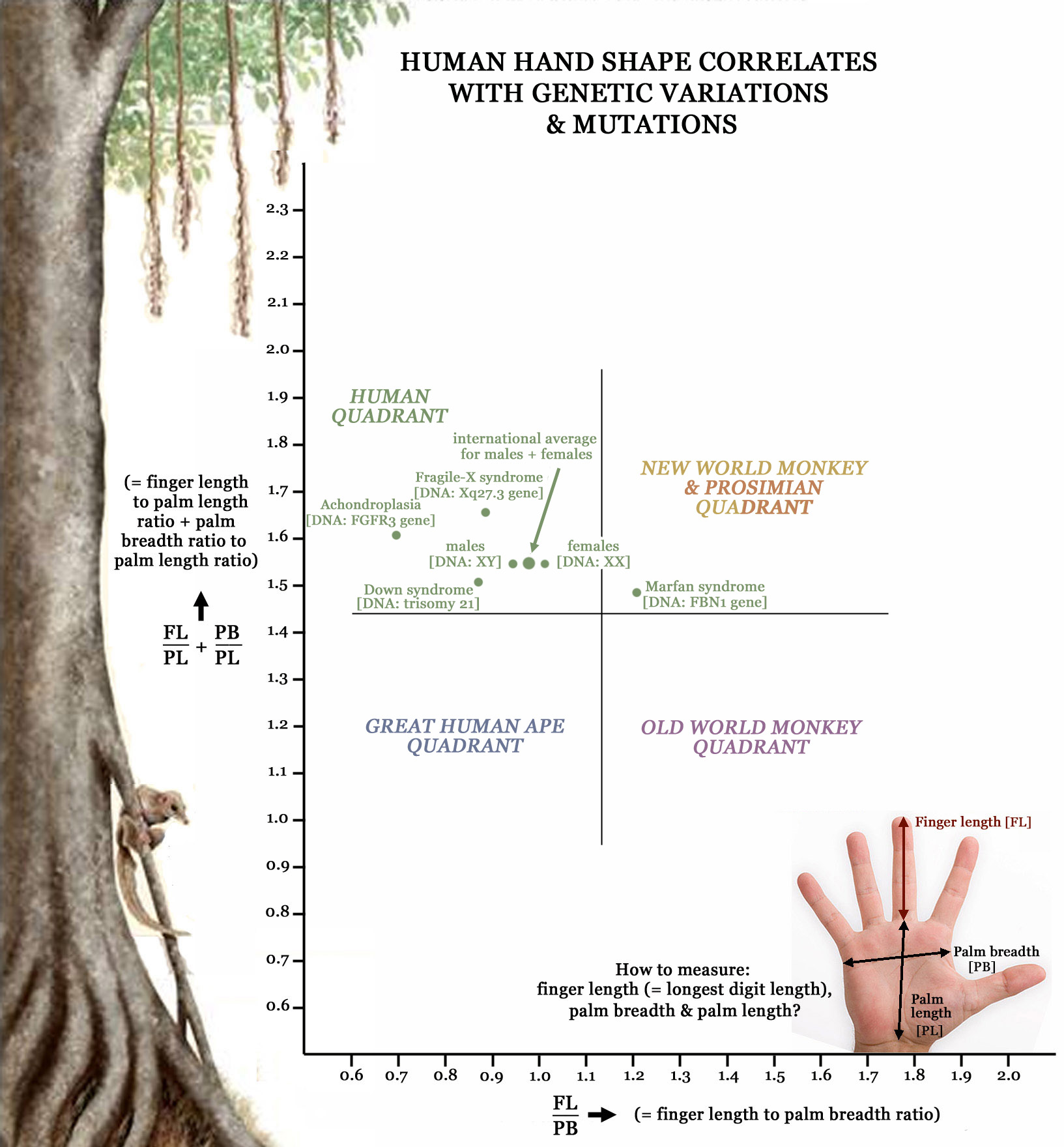
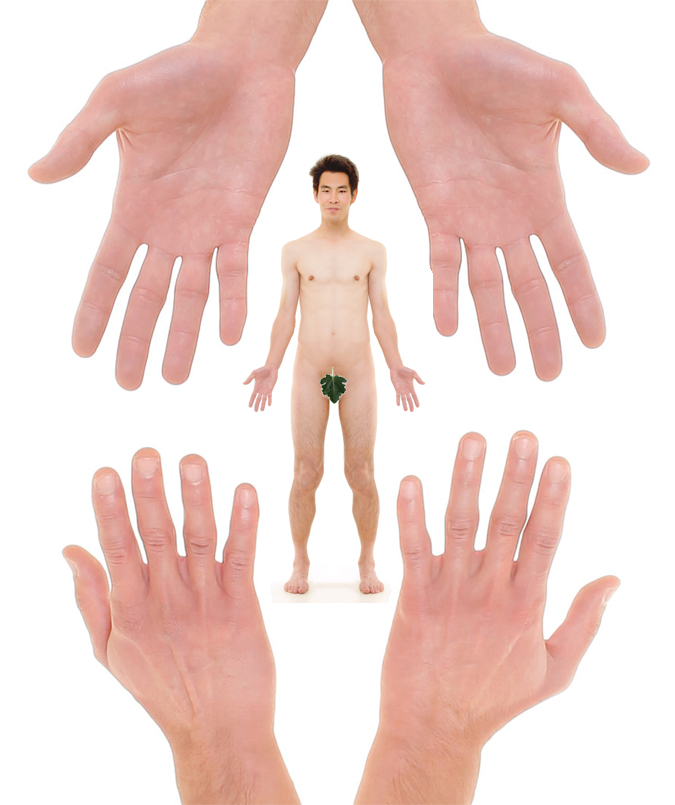
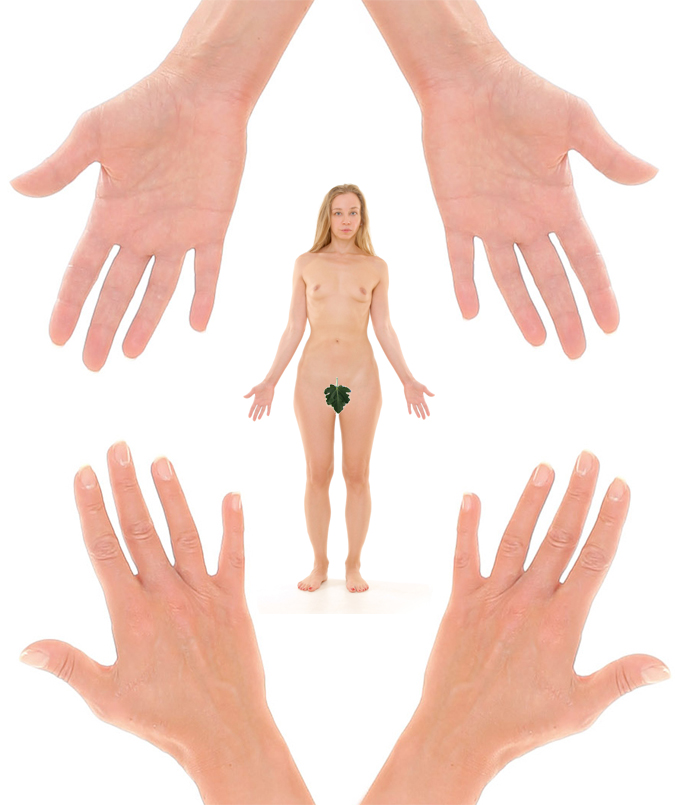

ADDITIONAL FEATURED CONTENTS:
• Finger length & evolution!
• Finger length & genetics!
• Finger length & hormones!
- Finger length & evolution! -
The first illustration (above) shows that according the 'finger length index' (vertical axis) evolution shows a tendency where finger length (proportion) tends to become smaller in primate families which have a smaller genetic distance to humans; this e.g. explains why human apes have by average shorter fingers than monkeys & prosimians. These tendencies are seen in all three finger length proportion variants.
Interestingly, in the perspective of the primate families there are huge differences between the individual finger length proportion variants FL/PL (finger length to palm length) and FL/PB (finger length to palm breadth). Inside the approach based on FL/PB proportion is the average human finger length quite similar to the average finger length in the human ape family; however, in this approach the average FL/PB proportion is actually higher in Old World Monkeys than in New World Monkeys - which is in conflict with the general principle that finger lengths tends to become smaller with the distance to the human genome. Another rather remarkable phenomenon is seen in the approach based on FL/PL proportion, where human finger length is relatively high: almost as high as finger length in the New World Monkey family.
Therefore it is hard to say whether any of both approaches (FL/PB and FL/PL) is more significant than the other regarding the topic finger length & evolution.
For this reason it appears a sensible choice to combine both approaches in order to identify the most significant tendencies, and in the combined approach of the 'finger length index' it is fascinating to see a (surprizing) evolutionary tendency in human finger length.
Because contrary to the general tendency mentioned above (finger length proportions became shorter in primate families which have a smaller genetic distance to humans) the average human finger length proportion actually become longer than the average proportion in the human apes family.
Read further: Hand shape gives a clue about Genes, Chromosomes & DNA!
Primate hands in evolution!

- Finger length & genetics! -
Since the 19th century extreme manifestations in finger length have been recognized and interpreted as congenital characters appearing at birth and tending to be transmitted to offspring. This also explains how unusual variations became associated with specific genetic variations:
• Extreme short finger length [= brachydactyly, which has been linked to mutations in various genes] became associated with a sign for various genetic disorders such as: Down syndrome, achondroplasia (= dwarfism), Rubinstein-Taybi syndrome, Aarskog syndrome, Roberts syndrome, Apert syndrome, Bloom syndrome, Basal cell nevus syndrome, carpenter syndrome, Ehlers-Danlos syndrome, Cri-du-chat syndrome, Fanconi's anaemia, Holt Oram syndrome, Cohen syndrome, and Gorlin-goltz syndrome.
• Extreme long (slender) finger length [= dolichodactyly (or arachnodactyly, which has been linked to mutations in both fibrillin-1 and fibrillin-2 genes)] became associated with a sign for various genetic disorders such as: Marfan syndrome, Ehlers Danlos Syndrome, Loeys-Dietz syndrome, homocystinuria, Lujan frins syndrome, Haim-Munk syndrome, Antley-Bixler syndrome, Marden-Walker syndrome, and Spondylocostal dysostosis. NOTICE: The terms dolichodactyly (long finger length) and leptodactyly (slender finger length) are far less often used but they often are likewisely used as a synonym for arachnodactyly.
Interestingly, in the perspective of the primate families there are significant differences between the individual finger length proportion variants FL/PL (finger length to palm length) and FL/PB (finger length to palm breadth). Inside the approach based on FL/PB proportion it is interesting to see that finger length in Down syndrome and finger length in fragile-x syndrome do not appear to vary a lot; however, in the approach based on FL/PL proportion both syndromes do vary signficantly. However, in the latter approach it appears that fragile-x syndrome and Marfan syndrome do not appear to vary a lot; but inside the approach based on FL/PB proportion it becomes evident that finger length does vary dramatically between both syndromes.
Therefore, also in the perspective of genetics it is very hard to say whether any of both approaches (FL/PB and FL/PL) is more significant than the other.
For this reason it appears (again) a sensible choice to combine both approaches in order to identify the most significant tendencies, and in the combined approach it is fascinating to see that finger length in arachnodactyly, Down syndrome, fragile-x syndrome and Marfan syndrome clearly does vary significantly from the international average for human finger length (though this observation also applies to the FL/PB proportion approach).
Finally, it is quite fascinating to see that finger length in fragile-x syndrome is inconsistent in the approaches of FL/PB- and FL/PL proportion: only in the first approach finger length in fragile-x syndrome can be described as 'short', while in the latter approach finger length is even above the international average. This might explain why the significance of finger length was so far not widely recognized, but the proposed combined approaches should become helpful to recognize the significance of finger length + hand shape in fragile-x syndrome (see e.g. the illustration below + the illustration at the top of this article).
In line with the illustration at the top of this article (which e.g. describes how finger length varies in achondroplasia (= dwarfism), Down syndrome, fragile-x syndrome, and Marfan syndrome), the picture below likewisely displays how 'hand shape' varies in the most common genetic disorders.
Read further: Hand shape correlates with genetics & chromosomal characteristics!
Hand shape correlates with genetics & chromosomal characteristics!

- Finger length & hormones! -
Even though finger length proportion is usually largely determined by growth factors that are in control of genetics, hormones are known to play a role as well. This is not really surprizing in the perspective of the fact that 2d:4d digit ratio is known to represent prenatal sex hormone levels in utero.
Especially the pituitary gland located at the base of the brain is involved in body growth as it produces growth hormone. Interestingly, the size of pituitary gland varies between males and females: over the years various studies have indicated that the height of the pituitary gland is typically more than 5% higher in females. It's hard to tell whether this partly explains why finger length sexe differences are typically also about 5% higher in females than in males: 7% in the FL/PB proportion approach and almost 3% in the FL/PL proportion approach. However, one should be aware here that the hormonal differences between the sexes are in the first place largely determined by genetics!
Hands display many features of sexual dimorphism!
 
The hormonal & genetic differences between people from different nations & ethnic groups are likely much smaller than the differences between males and females.
However, the chart presented at the top of this article displays a likewise tendency for national/ethnic differences as seen for the sexe differences: the FL/PB proportion approach is much more significant than the FL/PL proportion approach.
However, problems with the thyroid gland - which produces a hormone that regulates growth and metabolism - that may also have it's effect on finger length proportion; this is e.g. seen in Down syndrome where about 1 in 3 people experience serious problems related to hypothyroidism, which may result in delay of growth and intellectual development.
Since the early 20th century it has been known that a diseased or injured condition of the pituitary body may produce abnormal finger conditions (such as arachnodactyly, brachydactyly, dolichodactyly and leptodactyly).
An example of this is commonly seen in a condition called acromegaly, which involves pituitary gigantism. The twin pair displayed in the picture below illustrates how significant the effects of hormonal problems may become.
In the perspective of hormonal influences it appears that the FL/PB perspective is potentially more significant than the FL/PL perspective; however, unfortunately very little is known about how body proportions and hormonal glands exactly vary between nations & ethnic groups and therefore it remains unclear whether the approach of FL/PB proportion is really more significant in this perspective.
Read further: What can finger length reveal?
Acromegaly/gigantism: hands in an identical twin pair!

|
|